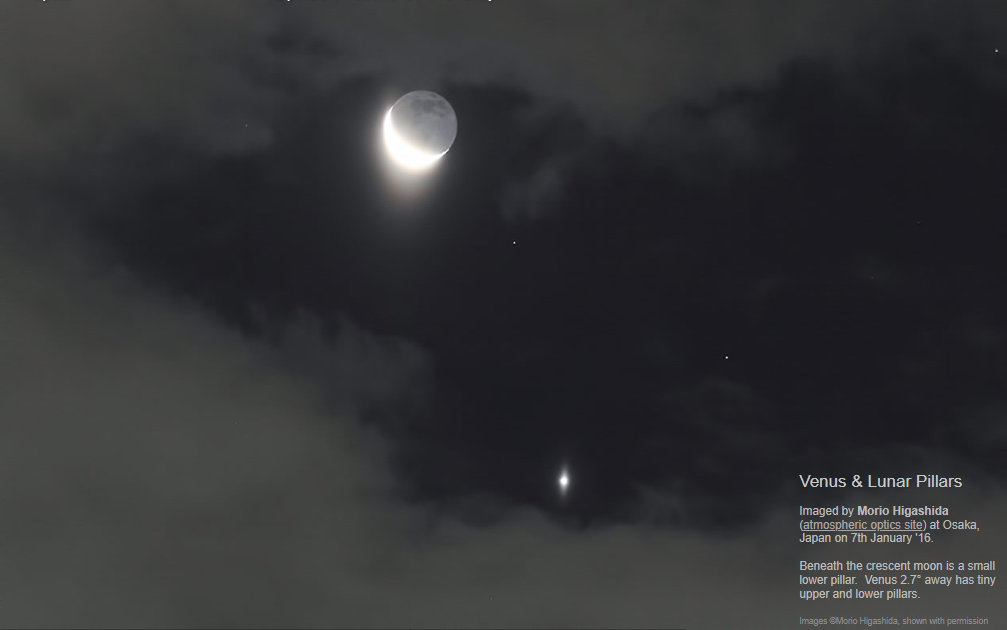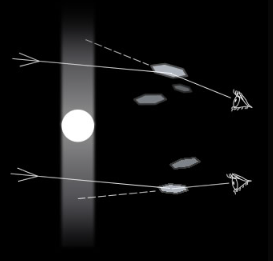Moon & Venus Pillars, Japan - OPOD
Moon & Venus Pillars: A Mesmerizing Atmospheric Phenomenon in Japan
Have you ever gazed at the night sky and been captivated by the beauty of celestial bodies? In the realm of atmospheric optics, there are fascinating phenomena that can enhance our celestial observations. One such spectacle is the Moon and Venus pillars, which were captured in a stunning photograph by Morio Higashida in Osaka, Japan on January 7th, 2016. In this article, we will delve into the intricacies of these pillars and unravel the science behind their enchanting appearance.
The Illusion of Pillars
Pillars are optical illusions created when suitable ice crystals align with a light source. While all light sources have the potential to generate pillars, those from stars are often faint and challenging to capture. In the case of the Moon and Venus pillars, the crescent moon serves as the primary source of light, accompanied by the radiant beauty of Venus positioned 2.7° away.
Ice Crystals and Pillar Formation
The magic behind pillar formation lies in the interaction between light and ice crystals suspended in the atmosphere. The most common contributors to pillar creation are wobbly plate-shaped ice crystals with hexagonal faces. These crystals act as tiny mirrors, reflecting and refracting light to produce the pillar effect. However, it is worth noting that horizontal column crystals can also contribute to the formation of these ethereal pillars, albeit less frequently.
Dispelling the Beam Myth
Despite their appearance, it is important to dispel any misconceptions about pillars. There are no actual beams of light extending upward or downward from the celestial bodies. Instead, the pillars are purely optical illusions created by the interaction of light with ice crystals in the atmosphere.
Capturing Pillars: A Photographer's Challenge
For photographers, capturing the elusive beauty of Moon and Venus pillars presents a unique challenge. The faintness of star-generated pillars requires skill and patience to capture them effectively. It takes a keen eye, technical expertise, and an understanding of atmospheric optics to immortalize these breathtaking phenomena through the lens of a camera.
The Mesmerizing Dance of Celestial Bodies
The Moon and Venus pillars serve as a reminder of the intricate dance between celestial bodies and the Earth's atmosphere. As the Moon and Venus align in the night sky, their radiant glow interacts with ice crystals, transforming the heavens into a canvas of wonder. The pillars add an ethereal touch to the celestial spectacle, captivating observers and igniting a sense of awe and curiosity about the mysteries of our universe.
Exploring Further
If you find yourself enthralled by atmospheric optics and yearning to learn more about the Moon and Venus pillars, we invite you to explore further resources. The original article capturing this captivating phenomenon can be found here. Delve into the world of atmospheric optics, immerse yourself in the wonders of the night sky, and unlock the secrets that lie beyond our earthly realm.
In conclusion, the Moon and Venus pillars are a mesmerizing atmospheric phenomenon that adds an enchanting touch to our celestial observations. Through the interplay of light and ice crystals, these optical illusions create an otherworldly display in the night sky. As we gaze upward, let us embrace the beauty of these pillars and marvel at the wonders that await us in the vast expanse of the universe.

Venus & Lunar Pillars
Imaged by Morio Higashida (atmospheric optics site) at Osaka, Japan on 7th January '16.
Beneath the crescent moon is a small lower pillar. Venus 2.7° away has tiny upper and lower pillars.
Images ©Morio Higashida, shown with permission

All light sources can generate pillars if suitable ice crystals are along the line of sight but those from stars are faint indeed. A challenge for photographers.
Most pillars are produced by reflection glints from the upper and lower hexagonal faces of wobbly plate-shaped ice crystals. More rarely, horizontal column crystals can make them.
The pillar is an illusion, there are no upward or downward beams of light.

Note: this article has been automatically converted from the old site and may not appear as intended. You can find the original article here.
Reference Atmospheric Optics
If you use any of the definitions, information, or data presented on Atmospheric Optics, please copy the link or reference below to properly credit us as the reference source. Thank you!
-
<a href="https://atoptics.co.uk/blog/moon-venus-pillars-japan-opod/">Moon & Venus Pillars, Japan - OPOD</a>
-
"Moon & Venus Pillars, Japan - OPOD". Atmospheric Optics. Accessed on November 26, 2024. https://atoptics.co.uk/blog/moon-venus-pillars-japan-opod/.
-
"Moon & Venus Pillars, Japan - OPOD". Atmospheric Optics, https://atoptics.co.uk/blog/moon-venus-pillars-japan-opod/. Accessed 26 November, 2024
-
Moon & Venus Pillars, Japan - OPOD. Atmospheric Optics. Retrieved from https://atoptics.co.uk/blog/moon-venus-pillars-japan-opod/.